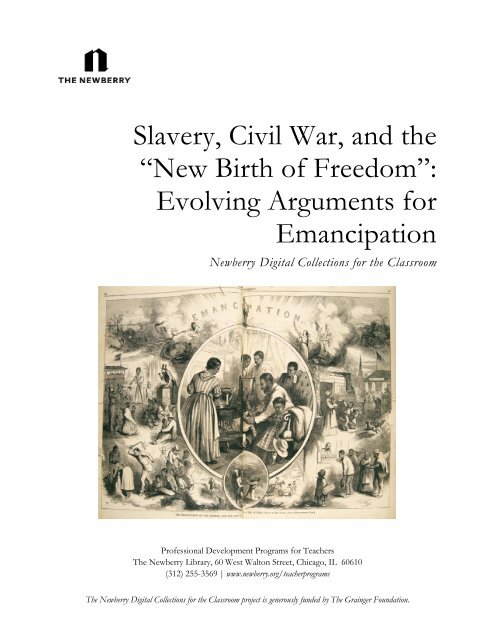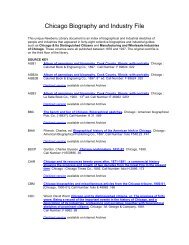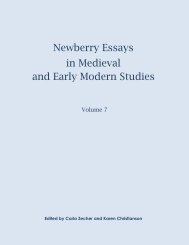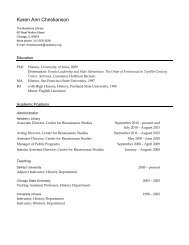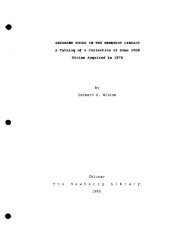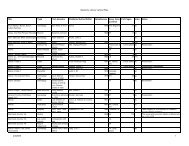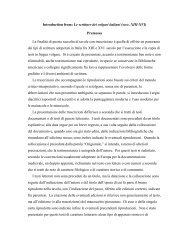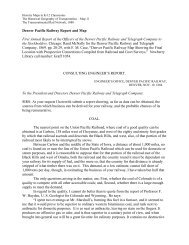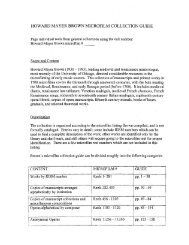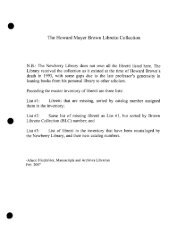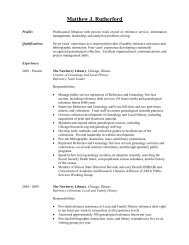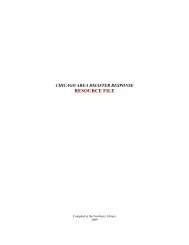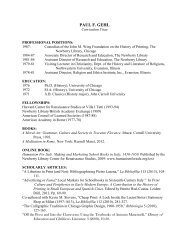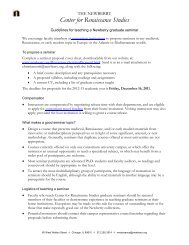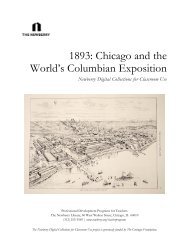Slavery, Civil War, and the - Digital Resources and Publications ...
Slavery, Civil War, and the - Digital Resources and Publications ...
Slavery, Civil War, and the - Digital Resources and Publications ...
You also want an ePaper? Increase the reach of your titles
YUMPU automatically turns print PDFs into web optimized ePapers that Google loves.
<strong>Slavery</strong>, <strong>Civil</strong> <strong>War</strong>, <strong>and</strong> <strong>the</strong>“New Birth of Freedom”:Evolving Arguments forEmancipationNewberry <strong>Digital</strong> Collections for <strong>the</strong> ClassroomProfessional Development Programs for TeachersThe Newberry Library, 60 West Walton Street, Chicago, IL 60610(312) 255-3569 | www.newberry.org/teacherprogramsThe Newberry <strong>Digital</strong> Collections for <strong>the</strong> Classroom project is generously funded by The Grainger Foundation.
<strong>Slavery</strong>, <strong>Civil</strong> <strong>War</strong>, <strong>and</strong> <strong>the</strong>“New Birth of Freedom”:Evolving Arguments for EmancipationNewberry <strong>Digital</strong> Collections for Classroom UseIntroductionTo twenty-first-century Americans, <strong>the</strong> case against slavery may appear self-evident. Most of us have nodoubt about <strong>the</strong> profound injustice of a system in which some people are <strong>the</strong> property of o<strong>the</strong>r people.However, nineteenth-century opponents of slavery faced a quite different social consensus on <strong>the</strong> issue. Theyhad to make <strong>the</strong> case for abolishing an institution that dominated <strong>the</strong> economic <strong>and</strong> social structure of <strong>the</strong>Sou<strong>the</strong>rn states. They also had to address widespread anxiety about how <strong>the</strong> nation would integrate freedslaves into its social, political, <strong>and</strong> economic fabric. The documents that follow bring toge<strong>the</strong>r arguments foremancipation written before, during, <strong>and</strong> after <strong>the</strong> <strong>Civil</strong> <strong>War</strong>. The collection allows students to trace <strong>the</strong>evolution of abolitionist arguments as well as to examine conflicts among writers over what emancipationwould entail.What arguments did writers make before <strong>the</strong> <strong>Civil</strong> <strong>War</strong> for <strong>the</strong> abolition of slavery? How did <strong>the</strong>yframe <strong>the</strong>ir appeals in moral, social, political, <strong>and</strong> economic terms?How did <strong>the</strong> war’s purpose shift from “saving <strong>the</strong> union” to destroying slavery?What would freedom mean for former slaves, for Sou<strong>the</strong>rn society, <strong>and</strong> for <strong>the</strong> nation as a whole,according to various writers both before <strong>and</strong> after <strong>the</strong> war?Document 1William Lloyd Garrison. “Immediate Emancipation.” The American Anti-<strong>Slavery</strong> Almanac. Vol. 1, no. 1. 1836. p. 29.Newberry Call No. H 5836 .028During <strong>the</strong> nineteenth century, almanacs were very popular publications, widely read <strong>and</strong> used by literateAmericans. Each year, <strong>the</strong> American Anti-<strong>Slavery</strong> Society distributed an almanac containing poems, drawings,essays, <strong>and</strong> o<strong>the</strong>r abolitionist tracts. The intent of <strong>the</strong> almanac was to instruct readers in <strong>the</strong> horrors of slavery<strong>and</strong> to persuade <strong>the</strong>m to join <strong>the</strong> abolitionist cause. William Lloyd Garrison was a prominent abolitionist <strong>and</strong><strong>the</strong> founder <strong>and</strong> publisher of <strong>the</strong> Liberator, an antislavery newspaper published between 1831 <strong>and</strong> 1865.Questions to Consider1. Garrison begins his description of “immediate emancipation” by telling his audience what <strong>the</strong> termdoes not mean. Why would he use this rhetorical device? What objections to emancipation doesGarrison anticipate from his readers?2. According to Garrison, what will be <strong>the</strong> results of emancipation? Would freed slaves achieve fullequality with whites?
Document 2“A Mo<strong>the</strong>r’s Anguish.” The American Anti-<strong>Slavery</strong> Almanac. Vol. 1, no. 2. 1837.pp. 43–44.Newberry Call No. H 5836 .028Antislavery literature often portrayed <strong>the</strong> deliberate destruction of black families under <strong>the</strong> institution ofslavery. Slaves’ marriages were not legally recognized <strong>and</strong> people could be sold away from <strong>the</strong>ir spouses,children, <strong>and</strong> siblings at <strong>the</strong>ir owners’ wills. The following piece addresses <strong>the</strong> trauma that slavery inflicted onfamilies through <strong>the</strong> story of a slave who murders her children to prevent <strong>the</strong>ir being sold. A similar storyserved as <strong>the</strong> basis for Toni Morrison’s contemporary novel, Beloved.Questions to Consider1. Describe <strong>the</strong> portrayal of <strong>the</strong> slave mo<strong>the</strong>r in both <strong>the</strong> story <strong>and</strong> <strong>the</strong> image.2. How does <strong>the</strong> story represent <strong>the</strong> choices faced by <strong>the</strong> mo<strong>the</strong>r <strong>and</strong> <strong>the</strong> decision that she makes?3. While he acknowledges <strong>the</strong> horror of infanticide, Mr. S attempts to justify to his niece—<strong>and</strong> <strong>the</strong>readers—<strong>the</strong> actions taken by <strong>the</strong> slave mo<strong>the</strong>r. What arguments does he make?4. How does this story support <strong>the</strong> arguments for emancipation voiced by groups such as <strong>the</strong> Anti-<strong>Slavery</strong> Society?Document 3“Oh Help <strong>the</strong> Contrab<strong>and</strong>.” The Harp of Freedom: A New <strong>and</strong> SuperiorCollection of Anti-<strong>Slavery</strong>, Patriotic <strong>and</strong> “Contrab<strong>and</strong>” Songs, Solos, Duets <strong>and</strong>Choruses. Part I. 1862.Newberry Call No. minus VM 1664 .A35 W32hIn 1861 <strong>the</strong> Confiscation Act declared that property used by <strong>the</strong> Confederate military, including slaves, couldbe confiscated by Union forces. This act was followed in March of 1862 with <strong>the</strong> Act Prohibiting <strong>the</strong> Returnof Slaves. Toge<strong>the</strong>r, <strong>the</strong>se acts not only created a new legal category for certain escaped slaves, but alsoprovided a common term, contrab<strong>and</strong>, for referring to <strong>the</strong>se slaves.Questions to Consider1. Who is <strong>the</strong> intended audience for this song?2. According to <strong>the</strong> lyrics, what do <strong>the</strong> contrab<strong>and</strong> desire from <strong>the</strong> “people in <strong>the</strong> North”?3. What assurances do “<strong>the</strong> contrab<strong>and</strong>” make to <strong>the</strong> people in <strong>the</strong> North in exchange for <strong>the</strong>irfreedom?
Document 4Abraham Lincoln. Letter to James Conkling. August 26, 1863. The Letters ofPresident Lincoln. 1863. pp. 20–21.Newberry Call No. E 5 .L6302During <strong>the</strong> <strong>Civil</strong> <strong>War</strong>, Union supporters in President Abraham Lincoln’s hometown of Springfield, Illinois,asked him to speak at a rally on September 3, 1863. Lincoln could not attend, but wrote this letter to be readat <strong>the</strong> ga<strong>the</strong>ring by his longtime friend, James C. Conkling. This letter was also sent to <strong>the</strong> New York StateUnion Convention, which was held at <strong>the</strong> same time. In <strong>the</strong> letter, Lincoln defends his emancipation policy.At <strong>the</strong> beginning of that year, Lincoln had issued <strong>the</strong> Emancipation Proclamation, which declared that “allpersons held as slaves within any State or designated part of a State, <strong>the</strong> people whereof shall <strong>the</strong>n be inrebellion against <strong>the</strong> United States, shall be <strong>the</strong>n, <strong>the</strong>nceforward, <strong>and</strong> forever free.” The proclamation alsoestablished that freed slaves would be allowed to serve in <strong>the</strong> Union army.Questions to Consider1. What arguments does Lincoln make for his authority to issue <strong>the</strong> Emancipation Proclamation?2. How will <strong>the</strong> Emancipation Proclamation contribute to <strong>the</strong> goal of saving <strong>the</strong> Union, according toLincoln?3. How does Lincoln present <strong>the</strong> Emancipation Proclamation as serving a military purpose? Why doyou think he felt compelled to make this argument? Does this rationale for <strong>the</strong> EmancipationProclamation support or conflict with <strong>the</strong> document’s moral significance?Document 5Thomas Nast. “General Sherman’s Rear Guard.” Harper’s Weekly.April 2, 1864. p. 212.Newberry Call No. folio A 5 .392Between November <strong>and</strong> December of 1864, Major General William Tecumseh Sherman conducted whatcame to be known as “Sherman’s March to <strong>the</strong> Sea.” As his army marched through Georgia, it destroyedcrops, l<strong>and</strong>, <strong>and</strong> equipment that could aid <strong>the</strong> Sou<strong>the</strong>rn cause. Along <strong>the</strong> way, hundreds of former slavesjoined <strong>the</strong> “rear guard” of <strong>the</strong> Union forces. The campaign ended when Sherman’s troops reached Savannah,Georgia, on December 21st.Questions to Consider1. Describe <strong>the</strong> different ways that African Americans are portrayed in <strong>the</strong> image.2. What kinds of relationships does <strong>the</strong> image represent between freed slaves <strong>and</strong> Union soldiers?3. How might this image have been used to fur<strong>the</strong>r <strong>the</strong> arguments in favor of emancipation?
Document 6Abraham Lincoln. Letter to Albert Hodges. April 4, 1864. In Horace Greeley,Greeley on Lincoln. 1893. pp. 69–70.Newberry Call No. E 5 G 8153Abraham Lincoln wrote this letter at <strong>the</strong> request of Albert Hodges, a Kentucky newspaper editor. In it,Lincoln restates thoughts that he had voiced in conversation with Hodges <strong>and</strong> two prominent Kentuckypoliticians. The letter illuminates Lincoln’s changing position on <strong>the</strong> question of emancipation.Questions to Consider1. What differences does Lincoln present between his personal position on slavery <strong>and</strong> <strong>the</strong> position tha<strong>the</strong> takes as <strong>the</strong> president of <strong>the</strong> United States? Why does he make this distinction? What does he seeas his primary obligation as president?2. What does Lincoln mean by <strong>the</strong> metaphor of amputating a limb to save a life? Why do you think hechooses a metaphor of <strong>the</strong> body?Document 7A.R. Waud. “The Freedmen’s Bureau.” Harper’s Weekly. July 25, 1868. p. 473.Newberry Call No. folio A 5 .392The Freedmen’s Bureau was a U.S. federal agency established at <strong>the</strong> end of <strong>the</strong> <strong>Civil</strong> <strong>War</strong> to aid freed slaves<strong>and</strong> refugees in <strong>the</strong> South. The agency assisted newly freed slaves in obtaining clothing, food, jobs, <strong>and</strong>housing. It also established schools for freed slaves. The Freedmen’s Bureau faced significant oppositionfrom white Sou<strong>the</strong>rners, especially for establishing its own court system to bypass Sou<strong>the</strong>rn civil courts,which were presumably biased against African Americans. In 1869 <strong>the</strong> Freedmen’s Bureau was disb<strong>and</strong>ed.Questions to Consider1. Describe <strong>and</strong> compare <strong>the</strong> appearances of <strong>the</strong> men on <strong>the</strong> left side <strong>and</strong> <strong>the</strong> right side of <strong>the</strong>illustration. What emotions do <strong>the</strong>ir faces <strong>and</strong> postures express?2. How does <strong>the</strong> man in <strong>the</strong> middle, <strong>the</strong> representative of <strong>the</strong> Freedmen’s Bureau, appear? What is hedoing? What is <strong>the</strong> role of <strong>the</strong> Freedmen’s Bureau, according to this image?
Document 8W.E. Burghardt Du Bois. “Of <strong>the</strong> Dawn of Freedom.” The Souls of BlackFolk. 1903. p. 38.Newberry Call No. H 5837 .244W.E.B. Du Bois was a prominent black intellectual, writer, <strong>and</strong> activist who famously declared, “The problemof <strong>the</strong> twentieth century is <strong>the</strong> problem of <strong>the</strong> color-line.” He criticized <strong>the</strong> position of ano<strong>the</strong>r importantblack leader, Booker T. Washington, who had argued that accommodation of post-Reconstruction racialsegregation would bring incremental progress to <strong>the</strong> race. Du Bois, in contrast, advocated immediate, fullpolitical <strong>and</strong> social equality for African Americans. “Of <strong>the</strong> Dawn of Freedom” provides a history ofReconstruction <strong>and</strong>, specifically, <strong>the</strong> Freedmen’s Bureau. Du Bois explains that many whites, particularly in<strong>the</strong> South, questioned <strong>the</strong> necessity as well as <strong>the</strong> constitutionality of <strong>the</strong> agency. Their argumentsinadvertently bolstered <strong>the</strong> case for black enfranchisement: If African American men could vote, <strong>the</strong>y wouldnot need <strong>the</strong> protection of <strong>the</strong> Freedmen’s Bureau. They could defend <strong>the</strong>ir own interests.Questions to Consider1. According to this passage, what were social conditions like in <strong>the</strong> South following <strong>the</strong> <strong>Civil</strong> <strong>War</strong>?2. Why did <strong>the</strong> nation face “a choice between suffrage <strong>and</strong> slavery”? What would be <strong>the</strong> effects of “<strong>the</strong>granting of <strong>the</strong> ballot to <strong>the</strong> black man”?3. What are <strong>the</strong> ramifications, according to Du Bois, of <strong>the</strong> dissolution of <strong>the</strong> Freedman’s Bureau <strong>and</strong><strong>the</strong> enactment of black male suffrage? Why does he see <strong>the</strong> black race as “sacrificed in its swaddlingclo<strong>the</strong>s on <strong>the</strong> altar of national integrity”?
Document 1: William LloydGarrison. “Immediate Emancipation.” The American Anti-<strong>Slavery</strong> Almanac.Vol. 1, no. 1. 1836. p. 29.Newberry Call No. H 5836 .028
Document 2: “AMo<strong>the</strong>r’s Anguish.” The American Anti-<strong>Slavery</strong> Almanac. Vol. 1, no. 2. 1837. pp. 43–44.Newberry Call No. H 5836 .028
Document 2: “AMo<strong>the</strong>r’s Anguish.” The American Anti-<strong>Slavery</strong> Almanac. Vol. 1, no. 2. 1837. pp. 43–44.Newberry Call No. H 5836 .028
Document 3: “Oh Help <strong>the</strong>Contrab<strong>and</strong>.” The Harp of Freedom: A New<strong>and</strong> Superior Collection of Anti-<strong>Slavery</strong>, Patriotic <strong>and</strong> “Contrab<strong>and</strong>” Songs, Solos,Duets <strong>and</strong>Choruses. Part I. 1862.Newberry Call No. minus VM1664 .A35 W32h
Document 4: Abraham Lincoln. Letterto James Conkling. August 26, 1863. The Letters of PresidentLincoln. 1863. pp. 20–21.Newberry Call No. E 5 .L6302
Document 5: Thomas Nast. “General Sherman’s Rear Guard.” Harper’s Weekly. April 2, 1864. p. 212.Newberry Call No. folio A 5 .392
Document 6: Abraham Lincoln. Letterto Albert Hodges. April 4, 1864. In Horace Greeley, Greeley onLincoln. 1893. pp. 69–70.Newberry Call No. E 5 G 8153
Document 7: A. .R. Waud. “ The Freedmen’s Bureau.” Harper’s Weekly. July 25, 1868. p. 473.Newberry Call No. folio A 5 .392
Document 8: W.E. Burghardt Du Bois. “Of <strong>the</strong> Dawn of Freedom.” The Souls of Black Folk. 1903. p. 38.Newberry Call No. H 5837 .244


